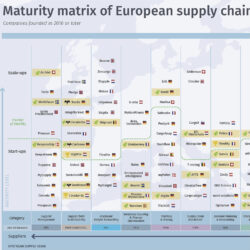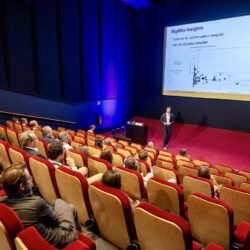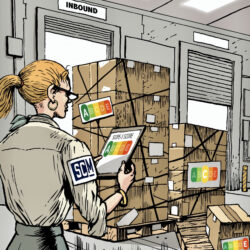Get ready for carbon emission audits now!

New rules that will make companies in the EU more accountable for their impact on the environment could be unsettling for some executives. The Corporate Sustainability Reporting Directive (CSRD) that becomes effective from 2024 will further extend a company’s obligation to report on sustainability issues. Its aim is to further stimulate the EU’s transition to a sustainable economy, but is likely to cause headaches for companies needing to report on Scope 3 emissions which are largely outside their immediate control. Effectively, it brings reporting on emissions to the same level as financial auditing.
By Helen Armstrong
As highlighted at the inNOWvate Supply Chain Event in Ede, the Netherlands, various (IT) specialists and tech companies already have smart tools and experience to help companies reduce their carbon footprint and increase their social responsibility. The main message for companies that are preparing for the new directive is: start right now.
Around 49,000 EU companies are likely to be affected by this new regulation which strengthens the existing rules on non-financial reporting introduced in 2014. It will mainly affect large companies that meet at least two of the following three criteria: employ more than 250 FTEs; have a net turnover of €40 million or above; have assets of at least €20 million. Also, small and medium-sized enterprises with public interest undertakings will have to publish detailed information on their environmental and societal footprint which will be publicly available to anyone interested.
Digitalization is key
At the Sustainable Summit held during the event, Carlos Mario Gómez (pictured), Marketing Director of Sweep, told delegates that digitalization is the key to reducing and monitoring emissions and that the supply chain needs to get to grips with tackling it. “We need to start acting now and this is where technology will be an enabler. Sweep has developed a step-by-step framework which any organization can implement. Once the foundation is in place, you can start to collaborate with suppliers and digitalize the collection of emission data. This is a big challenge because data collection can be difficult, especially for Scope 3 emissions,” he said.
While Scope 1 emissions are produced directly by companies, mostly in production plants, and Scope 2 mainly from energy that is bought in, Scope 3 accounts for all other indirect emissions, the majority of which are in the supply chain. “These account for the most – about 11 times those of Scope 1 and 2 combined – and they are the hardest to measure,” stated Gomez. “However, my key message is: don’t wait for the perfect system, start today! Start measuring and make sure you have a reliable, automated way to collect data and analyse it against targets.”
Gomez acknowledged that this can be very tricky because companies work with so many suppliers and trading partners. “You need to engage and communicate with suppliers in a way that makes it easy for them to join the journey. This is key. This is how Sweep can help you work with and reset your relationship with suppliers. In addition, our learning tool allows suppliers and partners to train themselves to collect emission data so they also see their own carbon footprint. This will help them to comply with upcoming regulations so it’s a win-win situation,” he said.
Start now by making assumptions
Andrea van Swet, Commercial Sustainability Manager at ClimatePartner, agreed that now is the time to act. “It is still very difficult to get all the primary data for Scope 3, but you cannot wait until you get perfect data. We have to start now and therefore we have to use secondary data to make assumptions. As we travel along the journey, data will improve as everyone gets on board.”
She told delegates that ClimatePartner’s sustainable data-driven solution will empower manufacturers and suppliers to accelerate the decarbonization of the supply chain as they move to the next level. “We have one of the largest greenhouse gas emission databases because we work with many industries and international clients. We can compare a lot of data and offer step-by-step guidance. Our ClimatePartner-certified label also allows you to communicate about climate action transparently to avoid accusations of greenwashing. We all have to climb the sustainable peak together, and collaboration is key to making this profitable.”
Visualizing the carbon footprint
Auke Annema, Business Consultant at BigMile, reiterated that supply chains need to be prepared as he described how the company offers a certified and accountable CO2 calculation tool that can visualize the entire carbon footprint throughout a supply chain, including Scopes 1, 2 and 3: “We already have a large interactive application which our users can use to measure and get insights into their CO2 footprint. For example, you can see which customer is responsible for which emissions in the supply chain and where you can make the most impact to reduce CO2 effectively and responsibly. It’s good to have reporting in place, but the next step is to reduce your emissions.”
The BigMile software platform for transport-related carbon-emission optimization shows various shipment scenarios, which could be combinations of road, ship and train. “The lead time may be longer but if you can substantially reduce CO2 and it’s more sustainable, it is usually also more profitable,” said Annema.
Sustainable delivery option
Even if it takes longer, sustainable delivery can soon become a competitive advantage in e-commerce, claimed Peter van den Hoven, founder of omnichannel delivery platform StoreShippers. He said that research by Metapack – a UK delivery platform – shows that 40% of online sale abandonment is caused by offering the wrong delivery option and that 43% of shoppers would rather do business with a company that offers sustainable shipping options.
“Why not position logistics as adding value – as a commercial proposition – rather than a cost centre? Use it as a way to retain business and increase conversion. People want the delivery to fit around their lives, rather than the other way round,” he said.
“We can help retailers and merchants to create the best delivery experience for customers by allowing them to use our omnichannel strategies to deliver from all their assets – such as hubs, DCs, e-commerce fulfilment centres – and connect to a carrier network of fast, sustainable, flexible courier partners that work slightly differently to traditional carriers. You can use these strategies to improve sustainability, customer experience and stock efficiency,” continued Van den Hoven.
Real-time information
To avoid customers abandoning an online purchase due to the delivery service, and to be able to offer a sustainable option, companies require real-time information that has been collected, extracted and returned within a second, Ronald Slegers told the delegates. Slegers is founder of DeliveryMatch, a cloud-based delivery order and shipping management platform that collects real-time data at the moment of purchase and executes and monitors the complete logistics chain.
“We know that more and more consumers want to know how sustainable the option is. Therefore, this data has to be available within a second. This might require extracting data from five or six systems at the same moment, as I don’t recommend putting all the data in one database – because firstly, logistics parties do not want to share data and secondly, data be will outdated in five minutes,” said Slegers.
“We are connected to BigMile and within one second we can show at point-of-checkout the CO2 emitted for the delivery option chosen and when the product will be delivered by back-checking transit times, pick-up times, etcetera. We then communicate this information to the customer. This service increases conversion, retention and sales and leads to a reduction in costs and CO2 emissions,” he continued.
Providing proof
However, just declaring that you have a sustainable supply chain is not enough. You need to prove it if you don’t want to be accused of greenwashing. Jonatan van Groos and Alexander Ellebrecht, both of ChainPoint, explained how they worked with Closing The Loop, a Dutch company that aims to reduce electronic waste. It set up an innovative business case with Vodafone for recycling mobile phones in Nigeria, where there is little downstream opportunity for recycling. Closing The Loop organized the collection of mobile phones by local people, who put them into Big Bags. The bags were brought back to Europe where the phones were compensated by Vodafone.
“However, when you make a claim you have to prove it, which is where ChainPoint comes in,” said Van Groos. “We have to prove 100% where and when the mobile phones are collected, and organize the traceability up to recycling in Europe. It is a challenge to collect all the data and provide the proof but our cloud-based supply chain collaboration platform enables suppliers to give you information you need. It allows companies to go the extra mile and prove that they are doing the right thing, right.”
However, Van Groos admitted that you can’t do everything with IT alone. The company worked with chocolate manufacturer Tony’s Chocolonely, which wanted to first create and then also prove that it runs a sustainable supply chain. “In this business there are many traceability challenges upstream, from the small farms, cooperatives, traders and exporters to the processors. These people need security, so you need to have a direct relationship with the farmers and offer them long-term contracts. Then they will have a willingness to share data, albeit with Excel sheets. We automate where we can, but sometimes we still need to pick up the phone to get the data.”
“Even though it is difficult when the final tier of the upstream supply chain is in different parts of the world with different levels of technology and accessibility, you have to collaborate with the entire supply chain if you want to guarantee the entire chain,” added Ellebrecht. “At some point you need to scale up and optimize traceability to prove sustainability and this is where IT comes in. We enable companies to make the first steps in an easy way. Just by making the carbon footprint a little bit smaller, everyone can make an impact,” concluded Van Groos.










